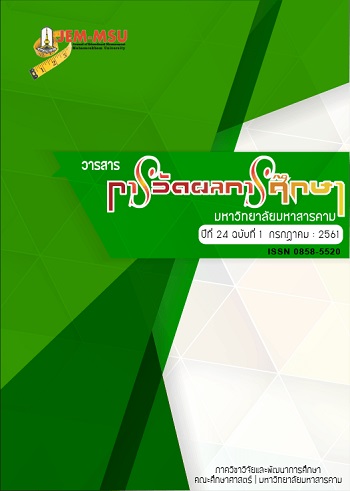การเปรียบเทียบเชาวน์ปัญญาของนักเรียนระดับประถมศึกษา ในจังหวัดมหาสารคาม จำแนกตามระดับการศึกษาผู้ปกครอง และลักษณะการอยู่อาศัย
Main Article Content
บทคัดย่อ
การวิจัยครั้งนี้มีวัตถุประสงค์ เพื่อ 1) ศึกษาเชาวน์ปัญญาของนักเรียนระดับประถมศึกษา ในจังหวัดมหาสารคาม 2) เปรียบเทียบเชาวน์ปัญญาของนักเรียนระดับประถมศึกษา ในจังหวัดมหาสารคาม จำแนกตามระดับการศึกษาของผู้ปกครอง และลักษณะการอยู่อาศัย กลุ่มตัวอย่างที่ใช้ในการวิจัย เป็นนักเรียนระดับประถมศึกษาในจังหวัดมหาสารคาม ภาคเรียนที่ 2 ปีการศึกษา 2558 จำนวน 5,053 คน ได้จากการสุ่มตัวอย่างแบบหลายขั้นตอน (Multi-stage Random Sampling) เครื่องมือที่ใช้ในการวิจัย คือ แบบทดสอบเชาวน์ปัญญาThe Colored Progressive Matrices (CPM)สำหรับเด็กอายุ 5-11 ปี มีลักษณะเป็นภาพสี จำนวน 36 ข้อวิเคราะห์ข้อมูลโดยการหาค่าร้อยละ ค่าเฉลี่ย ส่วนเบี่ยงเบนมาตรฐาน และทดสอบสมมติฐานด้วยการวิเคราะห์ความแปรปรวน(Analysis of Variance : ANOVA)ผลการศึกษาพบว่า
- นักเรียนประถมศึกษาในจังหวัดมหาสารคาม มีระดับเชาวน์ปัญญาโดยภาพรวมอยู่ในระดับเกณฑ์เฉลี่ย ( IQ เฉลี่ยเท่ากับ85)
- นักเรียนส่วนใหญ่มีเชาวน์ปัญญาอยู่ในระดับเกณฑ์เฉลี่ย (ร้อยละ 46) รองลงมาคือระดับต่ำกว่าเกณฑ์เฉลี่ย (ร้อยละ 24.14) และระดับคาบเส้นสติปัญญาบกพร่อง(ร้อยละ 5.13) ตามลำดับ
- นักเรียนที่มีผู้ปกครองมีระดับการศึกษาสูงทุกระดับมีเชาวน์ปัญญาอยู่ในระดับเกณฑ์เฉลี่ย
- นักเรียนที่มีลักษณะการอยู่อาศัยต่างกันเกือบทุกลักษณะ มีเชาวน์ปัญญาอยู่ในระดับเกณฑ์เฉลี่ย ยกเว้นนักเรียนที่อาศัยอยู่กับบิดามีเชาวน์ปัญญาระดับต่ำกว่าเกณฑ์เฉลี่ย
- ผลการเปรียบเทียบเชาวน์ปัญญาของนักเรียนประถมศึกษาในจังหวัดมหาสารคามจำแนกตามระดับการศึกษาของผู้ปกครอง และลักษณะที่อยู่อาศัยพบว่า
2.1) นักเรียนที่ผู้ปกครองมีระดับการศึกษาต่างกัน มีระดับเชาวน์ปัญญาไม่แตกต่างกัน
2.2) นักเรียนที่มีลักษณะการอยู่อาศัยต่างกัน มีระดับเชาวน์ปัญญาไม่แตกต่างกัน
Article Details
เนื้อหาและข้อมูลในบทความที่ลงตีพิมพ์ในวารสารการวัดผลการศึกษา มหาวิทยาลัยมหาสารคาม ถือเป็นข้อคิดเห็นและความรับผิดชอบของผู้เขียนบทความโดยตรง ซึ่งกองบรรณาธิการวารสาร ไม่จำเป็นต้องเห็นด้วย หรือร่วมรับผิดชอบใดๆ
บทความ ข้อมูล เนื้อหา รูปภาพ ฯลฯ ที่ได้รับการตีพิมพ์ในวารสารการวัดผลการศึกษา มหาวิทยาลัยมหาสารคาม ถือเป็นลิขสิทธิ์ของวารสารการวัดผลการศึกษา มหาวิทยาลัยมหาสารคาม หากบุคคลหรือหน่วยงานใดต้องการนำทั้งหมดหรือส่วนใดส่วนหนึ่งไปเผยแพร่ต่อหรือกระทำการใดๆ จะต้องได้รับอนุญาตเป็นลายลักษณ์อักษรจากวารสารการวัดผลการศึกษา มหาวิทยาลัยมหาสารคาม ก่อนเท่านั้น
เอกสารอ้างอิง
2. กรมสุขภาพจิต.(2554). การสำรวจสถานการณ์ระดับสติปัญญาเด็กนักเรียนไทย 2554.กรุงเทพฯ:กรมสุขภาพจิต กระทรวงสาธารณสุข.
3. กรมสุขภาพจิต. (2554b). สมองเด็กไทย...รอไม่ไหวแล้ว. โครงการ IQ EQ พัฒนาสติปัญญาเด็กไทย. เข้าถึงจาก http://rajanukul.go.th/new/_admin/download/ 5-4522-1449627567.pdf.
4. ปราณีชาญณรงค์ และ บัณฑิต ศรไพศาล. (2553). รายงานวิจัยการพัฒนาเครื่องมือวิจัยเชิงสำรวจ
สถานการณ์ระดับสติปัญญาเด็กไทย. กรุงเทพฯ: โรงพิมพ์มหาวิทยาลัยธรรมศาสตร์.
5. สมาคมผู้สื่อข่าวไทย-จีน (14 มกราคม 2560).FIT เสนอนโยบายพัฒนาเด็กไทยมีคุณภาพ หลังพบไอคิวต่ำ. เข้าถึงจากhttp://www.tcjapress.com/2017/01/14/future-innovative-thailand-institute/
6. สุชีรา ภัทรายุตวรรตน์, กนกรัตน์ สุขะตุงคะ, จริยา จันตระ, วิลาสินี ชัยสิทธิ์, กีรติ บรรณกุลโรจน์, สร้อยสุดา อิ่มอรุณรักษ์.( 2543 ). การสร้างเกณฑ์ปกติของแบบทดสอบ Standard Progressive Matrices ในกลุ่มประชากรไทย. วารสารสมาคมจิตแพทย์แห่งประเทศ. 45(1), 45-57.
7. สุธรรม นันทมงคลชัย (2559). ครอบครัว การอบรมเลี้ยงดู และพัฒนาการเด็กปฐมวัยในประเทศไทย.วารสารสาธารณสุขศาสตร์.46(3), 205 - 210
8. อริยะ สุพรรณเภษัช. (2545). พัฒนาI.Q. E.Q. M.Q. และสมาธิด้วยพลังคลื่นเสียง. กรุงเทพฯ: โรงพิมพ์มหาจุฬาลงกรณ์ราชวิทยาลัย.
9. Gardner, Howard. (1999). Intelligence Reframed. Multiple intelligences for the 21st century. New York: Basic Books.
10. Jensen, A. (1969). How Much Can We Boost IQ and Scholastic Achievement. Harvard. Educational Review, 39(1), 1-123, doi.org/10.17763/haer.39.1.l3u15956627424k7.
11. Kendler, K.S., Turkheimer, E., Ohlsson, H., Sundquist, J. &Sundquist, K. (2015). Family
Environment and the malleability of cognitive ability: A Swedish national home-reared and adopted-away cosibling control study. PNAS, 112(15). 4612–4617, doi:
10.1073/pnas.1417106112.
12. Meador, K.J.(2011).Relationship of child IQ to parental IQ and education in children with fetal antiepileptic drug exposure.Epilepsy Behavior. 21(2): 147–152.doi:
10.1016/j.yebeh.2011.03.020
13.Nisbett, R.E., Aronson, J., Blair, C.,Dickens, W., Flyn, J., Halpern, D.F…(2012). Intelligence: New findings and theoretical developments.American Psychologist, 67(2), 130-
159.
14. Raven, J., Raven, J.C., & Court, J.H. (2004).Manual for Raven’s Progressive Matricesand Vocabulary Scale Section 3 Section 3 Standard Progressive Matrices(including the
Parallel and Plus versions) 2000 edition: Updated 2004.Oxford: OPP.
15. Sattler, J.M. (2008). Assessment of Children: Cognitive foundations. San Diego: Jerome M. Sattler, Publisher, Inc.
16. Spearman, C. (1950). Human Ability. Macmillan: London.
17. The Nation. (2011). “Thai students found below global average”. The Nation.


